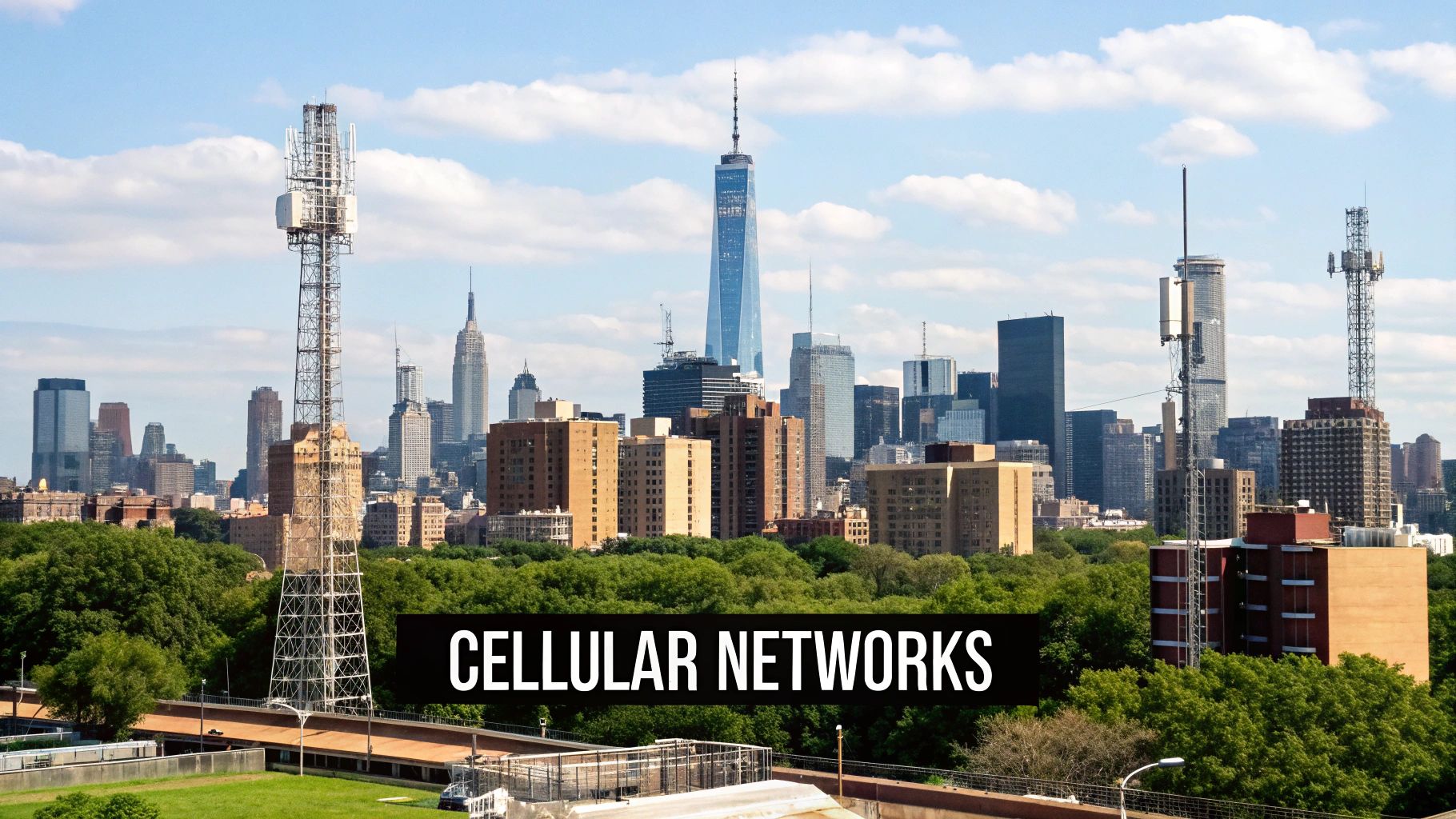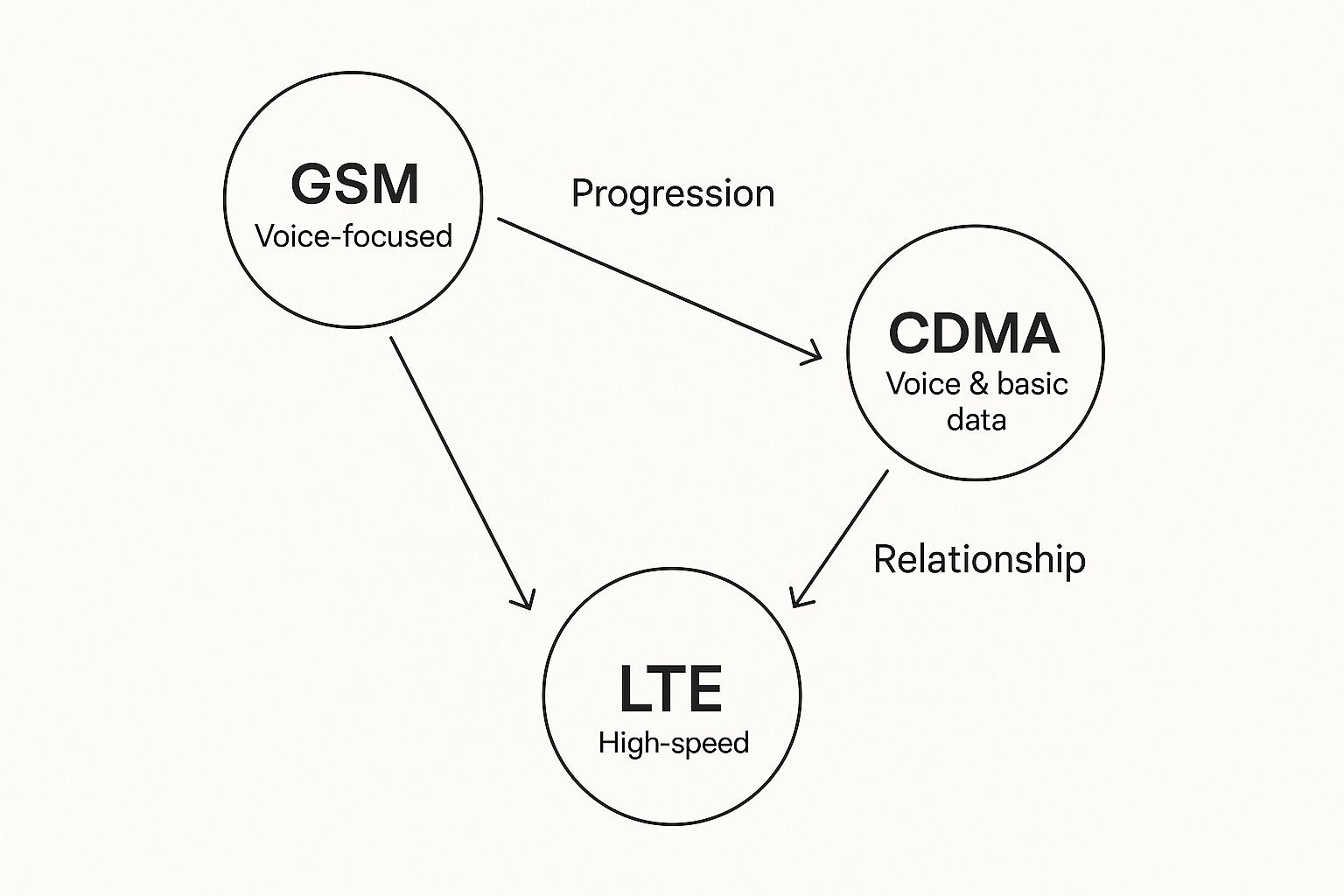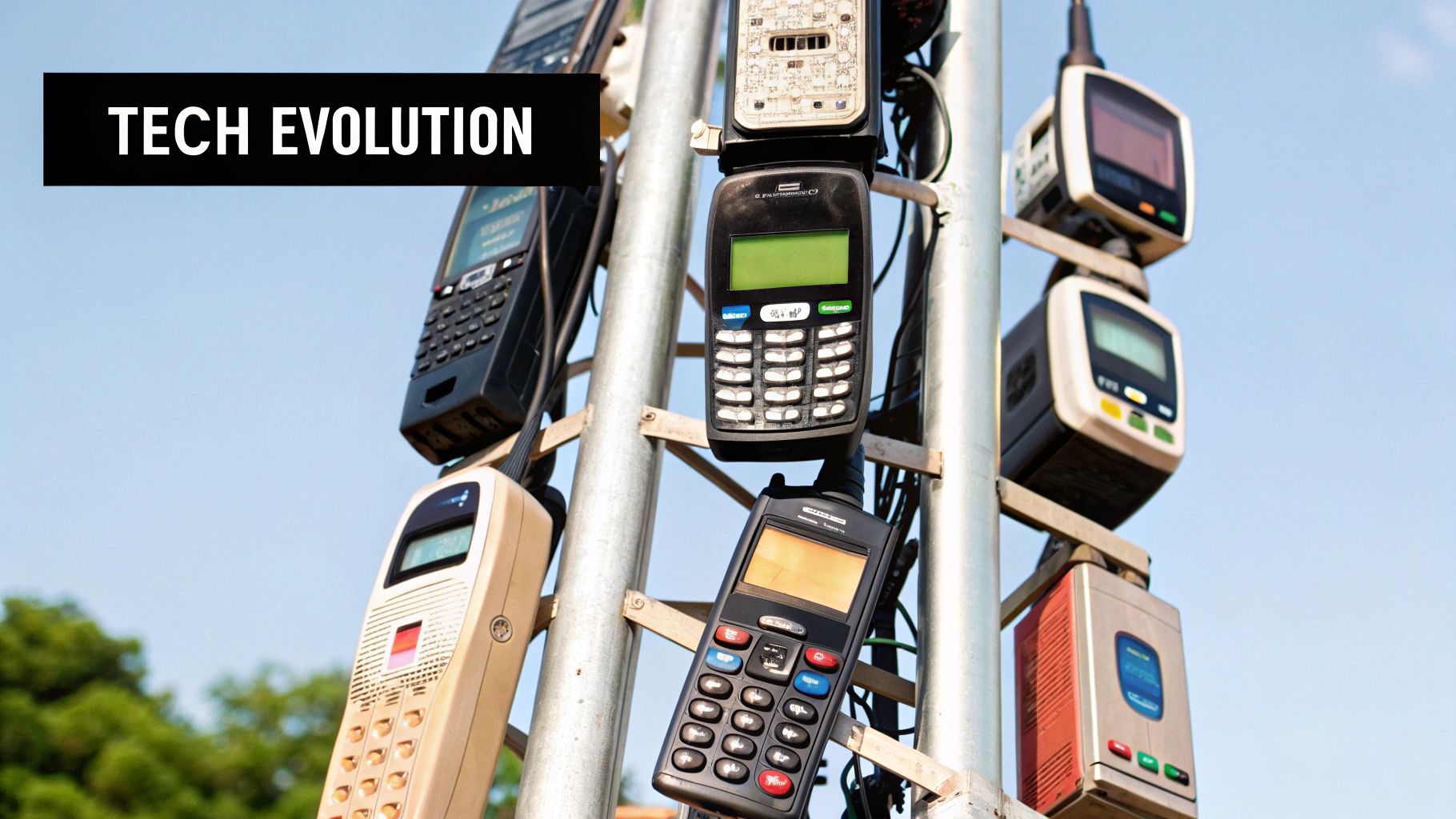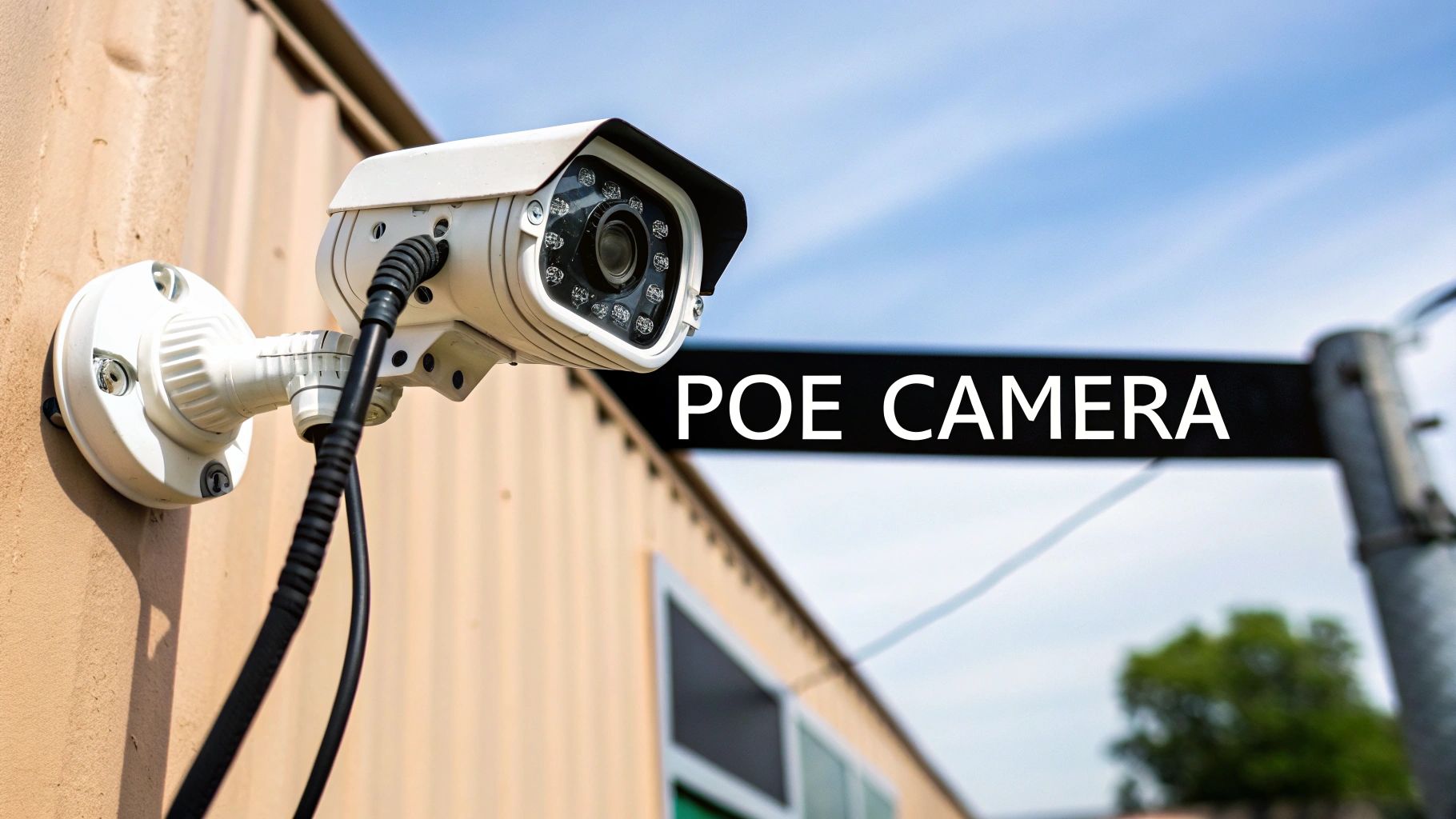Push-to-Talk Over Cellular: The Future of NZ Communication
Before we had mobile phones in our pockets and instant messages at our fingertips, New Zealand's communication network was all about telephone lines. The leap from those basic landlines to the powerful cellular network we have today is a story of constant innovation and a national drive to keep Kiwis connected, no matter where they are. This evolution has now paved the way for groundbreaking technologies like Push-to-Talk over Cellular (PoC), which combines the instant group communication of a two-way radio with the nationwide reach of the mobile network.
How Cellular Networks Evolved Across New Zealand

New Zealand has always punched above its weight when it comes to adopting new communication tech. Long before the first mobile call was made, the country was already a world leader in connecting its people. This forward-thinking attitude set the stage for everything that came next, especially the rollout of cellular services that now support advanced solutions like PoC.
To give you an idea, back in 1965, New Zealand ranked an incredible third in the world for telephone density. At the time, 35 percent of the population had a telephone service. That’s a massive investment in national infrastructure, and it’s the bedrock that our modern mobile networks were built upon. You can dive deeper into New Zealand's communication history to see how these early stages unfolded.
The Dawn of Mobile Communication
The shift from fixed landlines to a truly mobile, wireless network was a game-changer. The first analogue cellular network, which arrived in the late 1980s, was a massive step forward, finally letting us make calls on the go.
Sure, those early "car phones" and brick-like handhelds were clunky by today's standards, but they kicked off a new era of freedom and business efficiency. This first-generation (1G) network was all about voice. It worked, but the technology had its weaknesses—call quality could be patchy, security was almost non-existent, and the idea of mobile data was still science fiction.
Laying the Groundwork for a Digital Future
The real revolution came with the second generation (2G) of cellular tech in the 1990s. This was the critical jump from analogue to digital, bringing huge improvements that paved the way for the networks we use for everything from GPS tracking to sophisticated PoC systems.
Going digital delivered a few key advantages that quickly became the standard:
- Improved Voice Quality: Digital signals meant clearer, more reliable calls with far less static.
- Enhanced Security: Digital encryption made conversations private—a must-have for both personal and business use.
- Introduction of Data: 2G gave us basic data services like SMS (texting) and MMS (picture messaging), completely changing how we communicate.
- Greater Efficiency: Digital tech could squeeze more users onto the same frequency, boosting network capacity to handle the explosion in mobile phone ownership.
This journey from a world-class telephone system to a sophisticated digital network didn't happen by chance. It was the result of smart planning, major investment, and a vision for keeping New Zealand connected. This solid foundation made it possible for the later development of 3G, 4G, and the incredibly powerful 5G networks that now drive advanced solutions for businesses and individuals across the country.
Making Sense of Modern 4G and 5G Cellular Technology
Whenever you send a text, pull up a map, or use a PoC device, you’re tapping into New Zealand's powerful modern cellular network. But what’s actually happening behind the scenes? Getting your head around the difference between 4G and 5G is the key to understanding how this technology underpins everything from daily life to complex business operations.
Think of 4G as a really well-built, multi-lane motorway. It's fast, dependable, and easily handles the day-to-day traffic of our calls, messages, and data. It’s what allows us to stream in high-definition, download files quickly, and have stable video calls. It is, without a doubt, the backbone of mobile connectivity that most Kiwis rely on.
5G, on the other hand, isn't just a few extra lanes on that motorway—it's a complete redesign for the future. We're talking about dramatically faster speeds, a much bigger capacity to handle thousands of devices at once, and incredibly low latency, which is the technical term for lag or delay.
This image shows just how far we've come, tracking the evolution from the early days of cellular standards right up to the high-speed data networks we use today.

You can see how each generation built on the last, taking us from simple voice calls on 2G all the way to the data-heavy LTE (4G) standard that powers our connected lives.
Key Differences Between 4G and 5G
To really get a feel for the jump, let's break down the core improvements 5G brings to the table. These aren’t just small tweaks; they’re the advancements making entirely new technologies possible right here in New Zealand.
- Speed: In theory, 5G can be up to 100 times faster than 4G. What does that mean in the real world? Downloading a full-length HD movie could take mere seconds instead of several minutes.
- Latency: This is the time it takes for a signal to zip from your device to the network and back again. 5G slashes this delay to almost zero, which is absolutely critical for real-time applications like controlling remote machinery or enabling autonomous vehicles.
- Capacity: 5G networks can connect a massive number of devices at the same time, even in a small area. This is essential for the explosion of the Internet of Things (IoT), where everything from city traffic lights to sensors on a farm needs a rock-solid connection.
To give you a clearer picture, here’s a quick side-by-side look at how the two technologies stack up.
A Quick Comparison of 4G vs 5G Cellular Networks
| Feature | 4G (LTE) | 5G |
|---|---|---|
| Peak Speed | ~1 Gbps (Gigabit per second) | Up to 10 Gbps |
| Average Speed | 20-100 Mbps (Megabits per second) | 150-500 Mbps (and increasing) |
| Latency | 30-50 milliseconds | Under 5 milliseconds (potentially as low as 1ms) |
| Device Density | ~100,000 devices per km² | Over 1 million devices per km² |
| Primary Use Case | Mobile broadband, HD streaming, video calls | IoT, augmented reality, autonomous systems, smart cities |
As you can see, the leap is significant across the board, moving beyond just faster downloads to enabling a whole new ecosystem of connected devices.
The real story of 5G isn't just about making your phone a bit faster. It's about building the foundation for the next decade of connected technology—powering everything from smart cities and advanced manufacturing to more immersive digital experiences.
As networks get better, the older tech has to be phased out to make room. In New Zealand, providers are actively replacing older 3G infrastructure with more efficient 4G and 5G services across the country.
What This All Means for New Zealanders
This shift from 4G to 5G has some very real-world consequences for Kiwi businesses and individuals. For a logistics company, 5G’s near-zero latency could enable real-time GPS tracking with pinpoint accuracy, completely changing how they manage their fleet.
In agriculture, that massive device capacity allows farmers to deploy hundreds of soil sensors across their land to perfectly optimise irrigation and resource use. Emergency services stand to benefit hugely, too, with faster, more reliable comms during critical events, allowing them to send high-res video from a scene back to a command centre without any lag.
For the rest of us, it means smoother gaming, buffer-free 4K streaming, and the possibility of new augmented reality apps that seamlessly blend our physical and digital worlds. The move to 5G is a fundamental step in future-proofing New Zealand's digital infrastructure for whatever comes next.
Introducing Push-to-Talk Over Cellular (PoC)

What if you could take the instant, one-to-many connection of a traditional two-way radio and pair it with the nationwide reach of New Zealand's modern cellular network? That’s the simple idea behind Push-to-Talk over Cellular (PoC), a powerful communication tool built for professional teams on the move.
PoC uses the same robust 4G and 5G mobile networks we all rely on every day to deliver secure, clear, and immediate group communication. Where traditional radios are stuck within a limited signal range, PoC devices connect teams across the street or across the country. From Auckland to Invercargill, it’s all done with just the push of a button.
How PoC Bridges the Communication Gap
We all know the limitations of older tech. Traditional two-way radios are reliable workhorses, but their range is geographically constrained. A mobile phone has incredible reach but lacks the instant, one-to-many talk group function that’s so critical for team coordination.
PoC technology neatly merges the best of both worlds into one efficient solution.
It works by sending voice data over the mobile data network, similar to a VoIP call, but with the instant connection of a radio. This completely sidesteps the need for expensive private radio infrastructure like repeaters or costly frequency licenses. Instead, it just uses the existing, highly reliable cellular infrastructure that’s already in place.
PoC isn't just a walkie-talkie replacement; it's a complete upgrade. It turns a simple voice tool into a multi-functional device that boosts productivity, enhances worker safety, and streamlines operations by tapping into the power of the cellular network.
It’s no surprise this technology is quickly becoming the go-to choice for dynamic industries across New Zealand, including construction, transport, event management, and security.
Core Benefits of Modern PoC Systems
Switching to a PoC system delivers immediate, tangible advantages that go way beyond simple voice calls. Tapping into the cellular network unlocks a whole suite of digital tools that traditional radios just can't offer.
Here are a few of the key benefits:
- Nationwide Coverage: Communicate without limits wherever you have mobile coverage, getting rid of the frustration of dead spots and range issues.
- Crystal-Clear Audio: Digital audio processing and noise-cancelling tech deliver exceptionally clear voice quality, even on a loud construction site or factory floor.
- Enhanced Safety Features: Many PoC devices come with lone worker functions, emergency (SOS) buttons, and real-time GPS tracking for better health and safety compliance.
- Cost-Effectiveness: Using existing cellular networks means businesses can avoid the huge capital investment needed to build and maintain private radio networks.
- Scalability: Adding a new user is as easy as activating a new device. Your communication system can grow right alongside your business.
To get a better handle on how this technology works in the real world, you can explore the latest PoC solutions available in New Zealand.
Leading PoC Devices in New Zealand
A PoC system is only as good as its hardware. In New Zealand, two devices really stand out for their reliability, rugged design, and advanced features: the Motorola TLK110 and the Hytera P50.
The Motorola TLK110 is built for tough work environments. It combines the dead-simple operation of a two-way radio with the expanded capabilities of the cellular network. It’s designed for durability and packed with smart features like AI-powered noise suppression, making sure every message gets through clearly.
Then there’s the Hytera P50, a compact yet powerful PoC radio that excels in versatility. It offers advanced safety features in a user-friendly design, making it perfect for teams who need a reliable but discreet communication tool.
Both devices represent the next step in professional communication, using cellular technology to keep teams connected, safe, and productive, no matter where their work takes them.
A Closer Look at the Gear: The Motorola TLK110 and Hytera P50
The theory behind Push-to-Talk over Cellular (PoC) is one thing, but how it actually performs in the field comes down to the hardware. A solid PoC system relies on tough, purpose-built devices that can take a beating in professional environments. This is where top products like the Motorola TLK110 and the Hytera P50 really prove their worth, each bringing something different to the table for specific jobs.
These aren’t just fancy walkie-talkies. They are complete solutions built to improve safety, make teams more efficient, and handle the toughest conditions New Zealand’s worksites can throw at them. By taking a closer look, we can see how this specialised gear unlocks the full power of the cellular network for professional teams.
Motorola TLK110: The Rugged Workhorse
When your crew is working in noisy, demanding, and often harsh environments, you need a device that’s built like a tank. The Motorola TLK110 is engineered for exactly these challenges, pairing a rugged shell with clever internal tech. It’s a communication tool designed not just to survive, but to thrive where a normal mobile phone would quickly fail.
You can tell it’s tough just by looking at it. It boasts an IP67 rating, which means it’s completely sealed against dust and can handle being submerged in a metre of water for up to 30 minutes. That sort of durability makes it a perfect match for construction sites, port operations, and farm work where getting exposed to the elements is just part of the daily grind. The device is also dead simple to use, with a big, obvious push-to-talk button that’s easy to find and press, even with gloves on.
But its most impressive feature is probably its AI-powered noise suppression.
On a loud site, like a processing plant or a busy roading project, being able to hear each other clearly is a massive health and safety issue. The TLK110’s clever audio processing actively cuts out background noise, making sure every word gets through. In a high-stakes situation, that can make all the difference.
The TLK110 works hand-in-glove with Motorola's WAVE PTX platform, a subscription service for managing talk groups and dispatching. This powerful combo lets a dispatcher see the GPS tracking location of every device on a map, create new talk groups on the fly, and send out alerts, all using the nationwide coverage of New Zealand’s cellular networks.
Key features of the Motorola TLK110 include:
- AI-Powered Noise Suppression: Delivers crystal-clear audio by wiping out loud background distractions.
- IP67 Rating: Gives it top-tier protection against dust and water, making it a truly rugged piece of kit.
- Emergency Features: Has a dedicated emergency button and lone worker monitoring to keep your team safer.
- WAVE PTX Integration: Connects flawlessly with a powerful dispatch platform for next-level fleet and team management.
Hytera P50: The Versatile and Compact Communicator
While some jobs need brute strength, others call for a more compact and versatile tool that still packs a punch. This is where the Hytera P50 shines. It crams advanced PoC features and solid safety tools into a sleek, lightweight design that’s easy to carry and use, making it a great fit for security, event management, and logistics teams.
The P50 might be smaller, but it doesn't skimp on performance. It delivers crisp, clear audio and reliable connection over 4G cellular networks, keeping teams in touch across wide areas. Its compact size makes it less of a hassle to carry around, which is a big plus for staff who are always on the move or dealing with the public.
One of the best things about the Hytera P50 is its strong focus on protecting lone workers. In many New Zealand industries, from forestry to late-night security patrols, people often work by themselves in remote or potentially dangerous spots. The P50 is kitted out with features designed specifically for these risks.
It includes an emergency button that can fire off an instant alert to a dispatcher or a pre-set group, sending the user's precise GPS location along with it. It also offers Man Down and Lone Worker alarms. The Man Down feature uses a sensor to detect if the user has fallen, while the Lone Worker function makes the user check in at regular times. If they miss a check-in, an alert is automatically triggered. These features are vital for meeting modern health and safety rules and giving everyone peace of mind.
For teams who need a reliable, feature-rich, and easy-to-use PoC device without the heavy-duty bulk, the Hytera P50 is a standout choice. It’s proof that powerful communication and advanced safety can come in a small, user-friendly package.
Why New Zealand Businesses Are Embracing Cellular Solutions

Putting the tech specs aside for a moment, the real story of modern cellular communication is the massive impact it’s having on Kiwi businesses. This isn't just about new gadgets; it's a strategic shift that solves long-standing operational headaches and delivers a clear return on investment in efficiency and safety.
When businesses move to solutions like Push-to-Talk over Cellular (PoC), they're fundamentally upgrading how their teams connect and get the job done.
The biggest win? The sheer scale of the cellular network. Traditional radio systems are often stuck within a specific site or a small geographic area. Cellular technology blows those limits away, offering reliable, near-nationwide coverage.
This lets teams stay connected whether they’re in the Auckland CBD, on a remote farm in Canterbury, or managing a construction site in the Bay of Plenty.
This incredible reach is backed by solid infrastructure. New Zealand's mobile network coverage has been consistently strong, reaching 97 percent of the population between 2012 and 2016. That means almost every Kiwi was within range of a mobile signal, putting us slightly ahead of the global average.
Driving Operational Efficiency Across Industries
For any business with people and assets on the move—whether it's a delivery fleet, a team of service techs, or event staff—instant and reliable communication is absolutely non-negotiable. Cellular solutions smash communication silos and streamline workflows, unlocking major efficiency gains.
Imagine a logistics company running deliveries across both the North and South Islands. With PoC, a dispatcher in Tauranga can instantly talk to drivers in Wellington and Christchurch, giving them real-time updates and rerouting them around traffic. You just can't get that level of immediate, group-based coordination with standard mobile phones or range-limited radios.
But it’s not just about Push-to-Talk. Businesses are also using cellular networks for things like vehicle telematics for optimizing fleet management. This tech uses the cellular network to send back data on vehicle location, driver behaviour, and engine health, giving managers the insights they need to slash fuel costs and improve performance.
The core value is simple: cellular technology removes the geographic barriers to communication. It allows a business to operate as a single, connected unit, no matter how spread out its teams and assets are.
Enhancing Health and Safety Compliance
Modern PoC devices are more than just talk tools; they're powerful systems for protecting workers and meeting New Zealand's tough health and safety standards. For anyone in forestry, security, or infrastructure maintenance where lone workers are the norm, these features are mission-critical.
- Real-Time GPS Tracking: Supervisors can see every team member's exact location on a map, ready to send help fast if something goes wrong.
- Dedicated Emergency (SOS) Buttons: A single press sends an instant alert to a response group, complete with the user's location.
- Lone Worker and Man Down Functions: Smart devices can automatically trigger an alarm if a user falls or misses a scheduled check-in, a vital safety net for at-risk staff.
These features transform a communication device into a proactive safety system, giving both employees and management much-needed peace of mind.
A Scalable and Future-Proof Investment
One of the best reasons for businesses to get on board with cellular solutions is how easily they scale. As a company grows, so do its communication needs. With old-school radio, that could mean a huge spend on new frequencies or expensive repeater towers.
With cellular PoC, adding a new team member is as simple as activating another device. The system grows right alongside your business without the massive upfront cost. For businesses with seasonal peaks, like agriculture or event management, being able to scale up and down on a dime is a game-changer.
And even in those spots with patchy reception, a cellular booster can strengthen your connection and keep communication flowing. Investing in cellular technology isn’t just about solving today’s problems; it’s a forward-thinking move that sets your business up for whatever comes next.
Got Questions About PoC and Cellular Tech in NZ?
Whenever a new technology comes on the scene, it’s only natural to have a few questions. As Kiwi businesses look at making the switch to Push-to-Talk over Cellular (PoC), we hear the same practical queries pop up about performance, security, and just how tough the gear really is.
Let’s get into the most common questions we hear from decision-makers.
How Reliable Is the Cellular Network in Remote Areas?
This is usually the first thing we get asked, especially from folks in agriculture, forestry, and transport. The short answer is that while no network can cover every single square metre of the country, New Zealand's cellular network is surprisingly robust.
A massive amount of investment, both public and private, has pushed connectivity into nearly every corner of Aotearoa. Back in early 2021, internet access—which is what cellular data runs on—was already available to 94 percent of New Zealanders. Big projects like the Ultra-Fast Broadband programme are constantly expanding that reach, meaning even rural and remote operations can get a solid digital connection. If you're interested in the national rollout, you can explore the data on New Zealand's internet connectivity.
For those spots where the signal is a bit weak, a cellular booster is a simple and seriously effective fix. These devices grab the existing signal and amplify it, creating a reliable bubble of connectivity for your PoC devices and other gear. It’s a great way to close up any of those frustrating coverage gaps.
Are PoC Conversations Secure?
Absolutely. Security is a huge deal, particularly when you’re discussing sensitive operational details. PoC conversations running over modern cellular networks are in a different league of security compared to old-school analogue radios.
Unlike open radio frequencies that anyone with a scanner can listen in on, PoC traffic is digital. It's encrypted before it even leaves your device and travels through a secure tunnel over the 4G or 5G network. This makes it incredibly difficult for anyone to eavesdrop on your team's conversations, giving you a level of privacy that’s essential for any serious commercial or emergency service operation.
How Do PoC Devices Handle Tough Work Conditions?
Let’s be honest, a standard mobile phone isn't going to last long on a construction site or a fishing trawler. That’s exactly why purpose-built PoC devices like the Motorola TLK110 and Hytera P50 exist.
These radios are engineered from the ground up for the hard yards. They come with high IP (Ingress Protection) ratings—often IP67—which means they’re completely sealed against dust and can even be dropped in water without missing a beat. They're built to handle drops, vibrations, rain, and muck.
They are professional tools for professional environments. In the long run, investing in this kind of rugged gear is far more dependable and cost-effective than trying to make a fragile consumer smartphone do a job it was never designed for.
At Mobile Systems Limited, we've got the expertise and the right hardware to help your business get the most out of modern cellular communication.


